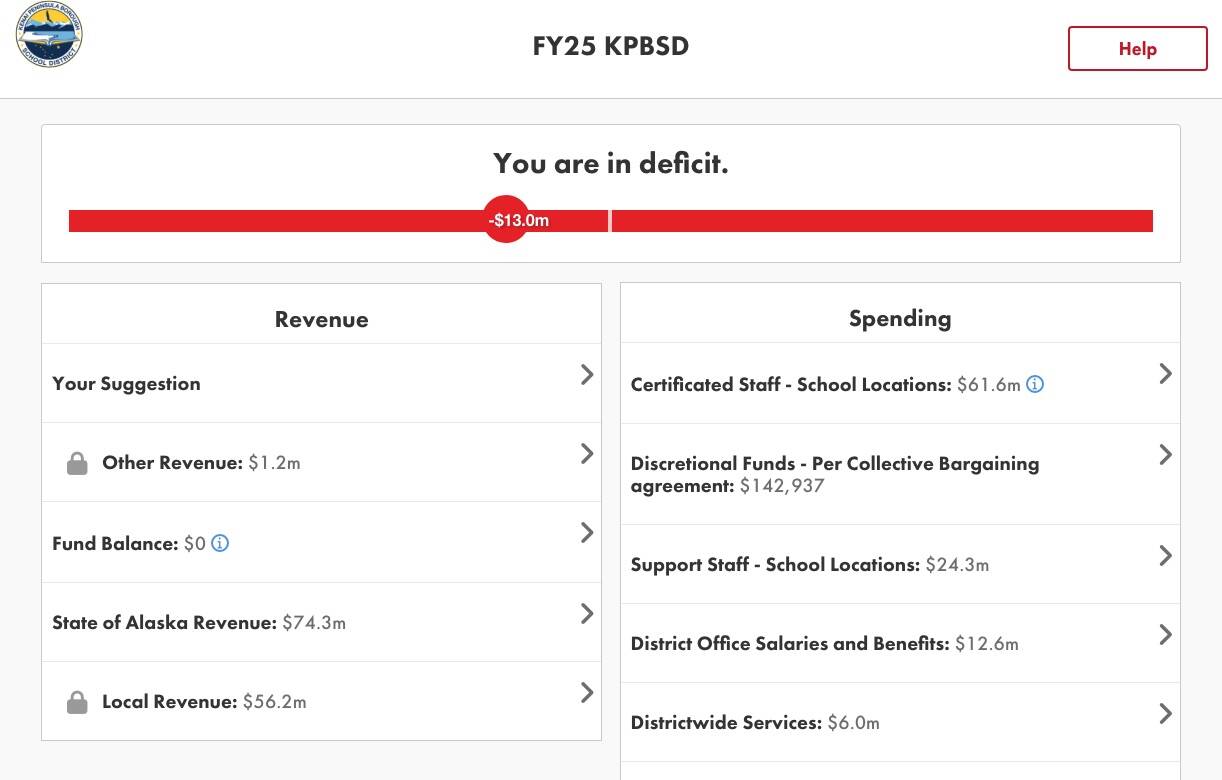Do you have opinions about what the Kenai Peninsula Borough School District should be doing to offset a forecast $13 million deficit heading into the next fiscal year? The district wants to hear from you.
New software, which went live Monday, gamifies KPBSD’s budget process by presenting users with a list of projected revenues and expenditures, and allowing them to toggle between eliminating or preserving various items in the budget. The program, called Balancing Act, has already been loaded with KPBSD’s financial data and shows a large red bar across the top of the webpage.
“You are in deficit,” a default status alert at the top of the page says.
For the upcoming fiscal year, KPBSD is facing a $13 million deficit. That is the amount the Balancing Act program starts with. Underneath the progress bar, budget elements are either designated “revenue” or “spending.”
Budget cuts that users are given the option to make include, among others, eliminating elementary school counselors, increasing the number of students in each class at different size schools and reducing the number of days worked by different types of employees. As users of the Balancing Act software make changes, the deficit amount adjusts accordingly.
Before adjusting elements of the school district’s budget, users must submit their name and affiliation with the school district. Recommendations and feedback will be submitted to school board members for consideration.
Not every piece of the budget can be toggled with through the Balancing Act software, because there are some expenses or revenues that will not change. The district expects to spend about $6.8 million, for example, on various utility payments, such as water and sewer services, natural gas and electricity. Users may still submit comments on those items through the software, though.
The software also allows users to see the budgetary impacts of drawing from savings to offset the deficit and of various increases to the State of Alaska’s base student allocation, or the amount of money school districts receive per student.
As of June 30, 2023, KPBSD has about $5.84 million in unassigned fund balance, or money the district has in savings that has not been designated for a specific purpose. The associated dropdown menu on Balancing Act gives users the option to use one-third, one-half or all the money to offset the deficit, which would save $1.9 million, $2.9 million or $5.8 million, respectively.
Similarly, users can visualize the impact different BSA increases would have on the deficit. A $100 increase to the BSA, for example, would increase the amount of money KPBSD receives from the State of Alaska by $1.7 million. A $300 increase, as has been proposed by the Alaska House Majority in Senate Bill 140, would increase state funding by $5 million.
At the time the Balancing Act software went live on Monday, several members of KPBSD leadership were in Juneau lobbying the Alaska Legislature for an increase to the BSA including KPBSD Superintendent Clayton Holland, KPBSD Assistant Superintendent Kari Dendurent and KPBSD Finance Director Elizabeth Hayes.
Hayes noted during Monday’s meeting that a note will pop up in the Balancing Act software if a user tries to increase the BSA amount.
“Legislative action is required for any increase to the Base Student Allocation (BSA),” the pop-up says.
Hayes said that alert comes up because a BSA increase isn’t guaranteed.
“If you were to select Foundation Funding, it’s going to give you this message that’s going to tell you that this is only going to happen with legislative action,” Hayes said. “So you can still select it, but if it doesn’t come through the Legislature, that money is not available for us to budget or pay bills with.”
Board members on Monday generally agreed that the software will be a valuable tool for members of the public to better understand the decisions that the district and board must make to balance the deficit. However, some expressed concerns that the software may oversimplify challenging decisions.
Jason Tauriainen, who represents Nikiski, said users may not understand the impacts of increasing the pupil-teacher ratio, which is one of the options the software gives to save money. It is easy, he said, to increase that ratio and “solve” the budget deficit math problem while not realizing how the change would impact classrooms.
“They solve their math puzzle … but they don’t understand that that is a human being at a school and raises class sizes, potentially, to a point where the building infrastructure doesn’t allow for classes that big in those particular classrooms,” Tauriainen said. “So I just think we have to — when we’re talking with people about this — I think we need to be careful. It’s not as simple as this looks.”
Board President Zen Kelly similarly pointed out the limits of the data as inputted to the Balancing Act software. The amount of money that the Kenai Peninsula Borough will give to the school district in fiscal year 2025, for example, may change, and not all of it is given to the district as cash.
“It’s great when we get additional money from the borough (but) if it’s all put into the in-kind budget … it doesn’t really help our general fund very much,” Kelly said, referring to non-monetary services the borough will provide to the district.
Roughly two months remain until the school district must submit a balanced fiscal year 2025 budget to the Kenai Peninsula Borough.
KPBSD’s Balancing Act budget simulation can be accessed at go.kpbsd.org/fy25-balancingact. Monday’s school board meetings can be streamed on the district’s BoardDocs webpage.
Reach reporter Ashlyn O’Hara at ashlyn.ohara@peninsulaclarion.com.


